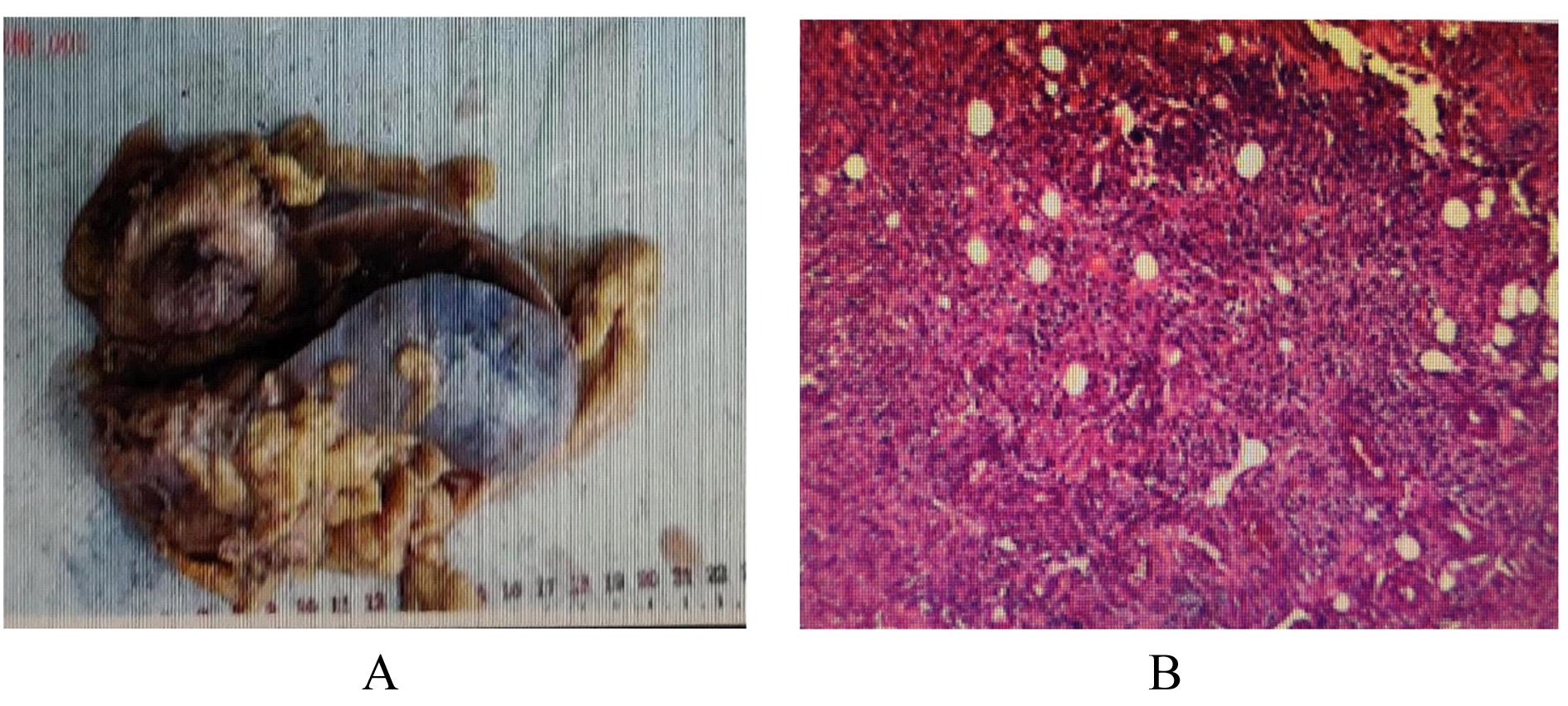| 1 |
封 扬, 夏 燕, 吴玲玲, 等. 肾上皮样血管平滑肌脂肪瘤6例的临床病理分析[J]. 安徽医药, 2022, 26(7): 1374-1377, 1488.
|
| 2 |
ESPINOSA M, ROLDÁN-ROMERO J M, DURAN I, et al. Advanced sporadic renal epithelioid angiomyolipoma: case report of an extraordinary response to sirolimus linked to TSC2 mutation[J]. BMC Cancer, 2018, 18(1): 561.
|
| 3 |
罗 敏, 蔡文超, 张 玮, 等. 肾上皮样血管平滑肌脂肪瘤(长径≤3 cm)的影像诊断[J]. 放射学实践, 2018, 33(12): 1295-1301.
|
| 4 |
YAMAKADO K, TANAKA N, NAKAGAWA T,et al.Renal angiomyolipoma: relationships between tumor size, aneurysm formation, and rupture[J]. Radiology, 2002, 225(1): 78-82.
|
| 5 |
CHONG J, ZHANG J P, NING C P, et al. Fat-poor renal angiomyolipoma combined with pseudoaneurysm: a case report[J].Ann Palliat Med, 2021,10(2):2343-2348.
|
| 6 |
ESMAT H A, NASERI M W. Giant renal pseudoaneurysm complicating angiomyolipoma in a patient with tuberous sclerosis complex: an unusual case report and review of the literature[J]. Ann Med Surg, 2021, 62: 131-134.
|
| 7 |
蔡胜章, 江耀明, 左步清, 等. 腹膜后肾外血管平滑肌脂肪瘤1例[J]. 南昌大学学报(医学版), 2020, 60(3): 53-54, 59.
|
| 8 |
VOS N, OYEN R. Renal angiomyolipoma: the good, the bad, and the ugly[J]. J Belg Soc Radiol,2018,102(1): 41.
|
| 9 |
陈一武, 何光智, 吴一彬, 等. 超声评价巨大肾血管平滑肌脂肪瘤并文献复习[J]. 中国医学影像技术, 2020, 36(S1): 47-50.
|
| 10 |
RANDLE S C.Tuberous sclerosis complex:a review[J]. Pediatr Ann, 2017, 46(4): e166-e171.
|
| 11 |
ISMAIL N F, ABDUL MALIK N MNIK, MOHSENI J,et al. Two novel gross deletions of TSC2 in Malaysian patients with tuberous sclerosis complex and TSC2/PKD1 contiguous deletion syndrome[J]. Jpn J Clin Oncol, 2014, 44(5): 506-511.
|
| 12 |
LANE B R, AYDIN H, DANFORTH T L, et al. Clinical correlates of renal angiomyolipoma subtypes in 209 patients: classic, fat poor, tuberous sclerosis associated and epithelioid[J]. J Urol, 2008, 180(3): 836-843.
|
| 13 |
VON RANKE F M, FARIA I M, ZANETTI G, et al. Imaging of tuberous sclerosis complex: a pictorial review[J]. Radiol Bras, 2017, 50(1): 48-54.
|
| 14 |
KUMAR G, PRASAD P S, KUMAR A, et al. Giant renal angiomyolipoma managed by selective renal angioembolization: a unique case report[J]. J Sci Soc, 2020, 47(2): 126.
|
| 15 |
FITTSCHEN A, WENDLIK I, OEZTUERK S, et al. Prevalence of sporadic renal angiomyolipoma: a retrospective analysis of 61, 389 in- and out-patients[J]. Abdom Imaging, 2014, 39(5): 1009-1013.
|
| 16 |
LOGUE L G, ACKER R E, SIENKO A E. Best cases from the AFIP: angiomyolipomas in tuberous sclerosis[J]. Radiographics, 2003, 23(1): 241-246.
|
| 17 |
SCHIEDA N, KIELAR A Z, DANDAN O A, et al. Ten uncommon and unusual variants of renal angiomyolipoma (AML): radiologic-pathologic correlation[J]. Clin Radiol, 2015, 70(2): 206-220.
|
| 18 |
任卫东, 常 才. 超声诊断学(第3版)[M]. 北京: 人民卫生出版社, 2013: 302.
|
| 19 |
谭昭敏, 宋 玲, 龚 明, 等. 肾血管平滑肌脂肪瘤超声与病理检查对照分析[J]. 中国超声医学杂志, 2006, 22(7): 537-539.
|
| 20 |
JENIL A A, SATHESAN B, SIVASETHAMBARAM K, et al. Endovascular embolization of ruptured giant pseudoaneurysm of renal angiomyolipoma in a patient with tuberous sclerosis[J]. Ceylon Med J, 2019, 64(3): 118-120.
|
| 21 |
OESTERLING J E, FISHMAN E K, GOLDMAN S M,et al. The management of renal angiomyolipoma[J]. J Urol, 1986, 135(6): 1121-1124.
|
| 22 |
MOCH H, CUBILLA A, HUMPHREY P, et al. The 2016 WHO classification of tumours of the urinary system and male genital organs-part A: renal, penile, and testicular tumours[M]. Lyon: IARC Press,2016: 65-66.
|
| 23 |
BRIMO F, ROBINSON B, GUO C, et al. Renal epithelioid angiomyolipoma with atypia: a series of 40 cases with emphasis on clinicopathologic prognostic indicators of malignancy[J]. Am J Surg Pathol, 2010, 34(5): 715-722.
|
| 24 |
BANI M A, LAABIDI B, REJEB S B, et al. A rare highly aggressive tumor of the kidney: the pure epithelioid angiomyolipoma[J]. Urol Case Rep, 2018, 18: 52-53.
|
| 25 |
苏世强, 刘丽哲, 苏晓哲, 等. 肾上皮样血管平滑肌脂肪瘤17例临床病理特征及诊治分析[J]. 大连医科大学学报, 2020, 42(1): 16-20.
|
| 26 |
CALIÒ, BRUNELLI M, SEGALA D, et al. Angiomyolipoma of the kidney: from simple hamartoma to complex tumour[J].Pathology,2021,53(1): 129-140.
|
| 27 |
马亚南, 任心爽, 于易通, 等. 肾血管平滑肌脂肪瘤伴肾静脉、下腔静脉及肺动脉栓塞1例[J]. 中华放射学杂志, 2022, 56(1): 99-100.
|
| 28 |
EBLE J N. Angiomyolipoma of kidney[J]. Semin Diagn Pathol, 1998, 15(1): 21-40.
|
| 29 |
王 涛, 高 宇, 肖 帆, 等. 肾血管平滑肌脂肪瘤伴Mayo Ⅳ级下腔静脉瘤栓1例报道[J]. 微创泌尿外科杂志, 2022, 11(4): 281-284.
|
| 30 |
杨恩广, 景锁世, 范光锐, 等. 肾血管平滑肌脂肪瘤的治疗进展[J]. 中国肿瘤, 2018, 27(10): 790-795.
|
 )
)









